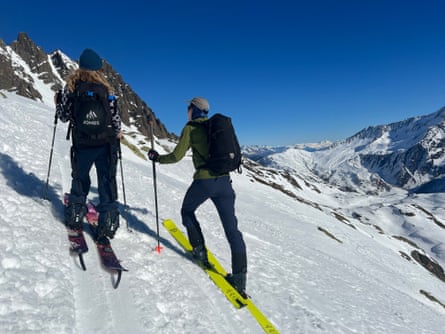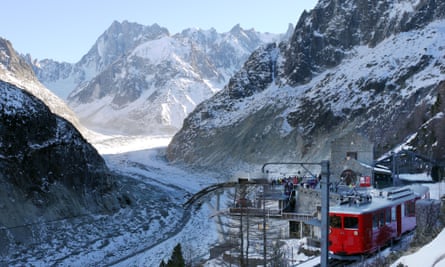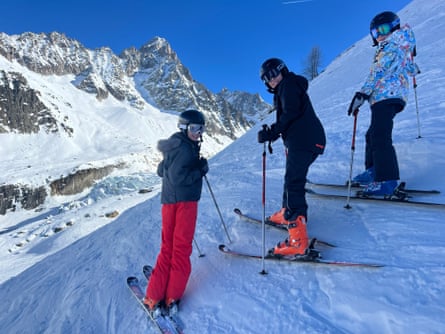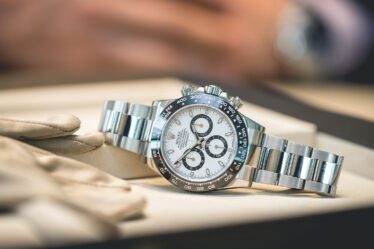
The Glacier du Tour sits on top of the mountain like a cresting wave frozen in time. From the nursery slopes of La Vormaine, to a soundtrack of playful shrieks, laughter and skis swishing through the slush, I admire its blueish hue and jagged blocks of ice, while lamenting how much it has retreated since I lived here 23 years ago.
The Mont Blanc massif is one of the most densely glaciated areas in the Alps and in the Chamonix valley, glaciers are visible from almost every vantage point, including each of the town’s four main ski areas: Le Brévent, La Flégère, Grands Montets and Le Tour (which includes the beginner slopes of La Vormaine).
Since the late 19th century, tourism in Chamonix has centred on the high-mountain environment of these glaciers. The majestic Glacier des Bossons, which looks like a frozen waterfall flowing between Mont Blanc and Frances’s the highest cable car, the Aiguille du Midi, provides the best view, with much of the town designed to point towards it. The Mer de Glace, the second-longest glacier in the Alps, reached by the Montenvers train or by skiing or snowboarding down the off-piste Vallée Blanche, is one of the region’s most popular attractions.
From next year, the Mer de Glace will host a glacier and climate interpretation centre, to address the evident threat these magnificent bodies of slow-moving ice are facing from global heating. Luc Moreau, a local glaciologist who has been studying Chamonix’s glaciers since 1987, tells me every glacier in the valley has melted significantly since the 1990s. His simulations suggest that by the end of the century, with the Alps heating at a rate above the global average, all the glaciers under 3,500 metres will have disappeared; the highest lift stops at 3,842 metres.
While they are still here, the glaciers are like a live laboratory where people can witness the effects of global heating first-hand and, Luc hopes, be inspired to do something about it. “They make visible what is invisible,” says Luc, who hosted President Emmanuel Macron at the Mer de Glace in 2020 and in January wrote to him urging swift action.
Until recently, ski resorts haven’t talked a great deal about the climate crisis – beyond flagging new eco hotels and snowmaking infrastructure – for fear of putting off holidaymakers or dampening the vibe for those already here. But in 2021, the Compagnie des Guides de Chamonix, the world’s oldest and largest association of mountain guides, decided to mark its 200-year anniversary by leaning into the problem and including stewardship of the environment as part of its remit.
To find out more, I spend a half day splitboarding (using a snowboard that divides in two to act as touring skis) with Brad Carlson, a high-mountain guide and ecologist, who has lived and worked in the area for more than a decade.

We begin our hike by taking the highest lift at La Flégère, then track left enjoying breathtaking views of the Glacier des Bossons, Mer de Glace, and Glacier d’Argentière across the valley, with the spiked peaks of the Mont Blanc Massif rising above them. It’s early February, but the weather is warm, sunny, and spring-like.
Brad tells me that guides used to often talk only unofficially about the environmental changes they were noticing. “It was a taboo subject,” he says, but now it comes up with about three-quarters of his clients.
As we cross the frozen Lac Blanc and make our way up towards the Col du Belvédère, we see other groups of ski tourers with guides, ranging in age from early 20s to early 60s.
“People might think if they come here, they’ll see something dying but the reality is it’s still as beautiful as ever,” says Brad, and I couldn’t agree more. “Mountain environments are always changing, and guides have had to adapt in the past.
“The challenge is to rebuild the perception of what people expect in the Alps, and to encourage a more flexible mindset.”
Guides want to move away from clients having particular objectives, such as climbing a specific mountain on a certain day or riding fresh powder snow. Instead, guests need to embrace the uncertainty of the conditions and ask the guide: “What makes sense right now?” As the snow season shortens, some guides are even embracing activities that aren’t dependent on snow, such as canyoning and rafting.

Another day, husband and I take the Montenvers train to the Mer de Glace. It’s a discombobulating experience: when I last snowboarded here in 2001, from the Vallée Blanche, there were 118 steps from the glacier to the cable car; we now descend 580. More steps have been added each year to compensate for the shrinking ice.
after newsletter promotion
Work has begun on a lift to replace the steps, and the Glaciorium interpretation centre will open next year, which through interactive displays will chart the evolution of glaciers, and our relationship with them. The hope is to preserve and enhance the memory of this pioneering site, while educating visitors on the effects of the climate crisis on the valley.
Zoe Hart, a high-mountain guide, who has lived here for more than 20 years, says talking to guests about what is going on is all well and good, but more is needed.
“These visits can be a tool in environmental action but it’s not enough to just educate people on their trip, have them feel sad, and then go home and forget about it,” she says. “We need to encourage tangible action to protect this resource while the tourists are here.”
Zoe directs her clients to environmental non-profits where they can make a contribution, while Brad suggests donating to the Alpine ecosystem research centre, CREA, and helping with citizen science projects that the team at CREA is developing. He hopes these will one day be incorporated into guided trips with clients.
The elephants in the room are the impact of tourism in this fragile environment and the carbon footprint of getting here. We travelled as four in a hybrid car, which is better than flying but not as good as taking the train, always tricky in the February school holidays.

For its part, much of Chamonix’s resort operations run on hydroelectric power, generated in part by meltwater from the valley’s glaciers. Its snow groomers still emit CO2, though the lift company is experimenting with hybrid machines and zero-emission HVO (hydrotreated vegetable oil) fuel and hopes to achieve carbon neutrality within 10 years. A project to build a biogas plant is under way. Buses and trains are free in the valley during winter for ski lift pass holders, many are hybrid and some buses run on natural gas.
“I don’t think the answer is guilting people into not coming here,” says Zoe – hiring mountain guides does support the local economy – though she also favours a tourist tax. “People who come to Chamonix spend a lot of money on accommodation, lift passes, dinners and travel: they could afford 1% of that to go towards something good.”
Toward the end of the week, we ski and snowboard to the dramatic Glacier d’Argentière with my son and his friends and their response is anything but sombre, eliciting a series of gasps and wows. Like most 13-year-olds they know all too well what the climate crisis may bring but it doesn’t stop them enjoying the here and now and appreciating this unique and fragile high-mountain environment.
The guided splitboard/ski tour was provided by Chamonix-Mont-Blanc Tourist Office: it costs from €105pp, chamonix-guides.com/fr Splitboard rental, from €70 a day, was provided by Zero G. Ski touring equipment can be rented at Intersport in Chamonix from €50 a day.



